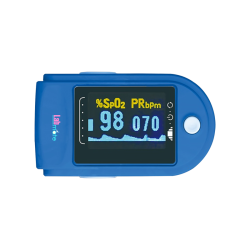
Pulse Oximeter LMPO-A100 is a compact and light-weighted oximeter that non-invasively monitors the degree of oxygen saturation of the patient's haemoglobin and pulse rate. It delivers an estimated SpO2 measurement range of 0–100% by determining the absorption of two wavelengths of light (660 nm [red] and 940 nm [infrared]) by blood. With an enhanced eye monitoring feature for visual observation, working parameters are easily visible on LED screen.
Get Quote| SpO2 Measuring range | 0-100% |
| PR Measuring range | 30-250 bpm |
| Accuracy | ±2% (70% - 100%), unspecified (<70%) for SpO2, ±2bpm or ±2% (select larger) for pulse rate |
| Resolution | 1% for SpO2 and 1 bpm for pulse rate |
| Power supply | 1.5V (two “AAA” size) alkaline batteries |
| Dimension | 57×31×32 mm |
 Simplified with 0.96″ color LED display with adjustable screen brightness
Simplified with 0.96″ color LED display with adjustable screen brightness
 Integrated with SpO2 probe and processing display module
Integrated with SpO2 probe and processing display module
 Quick and accurate measurement
Quick and accurate measurement
 Exhibits pulse rate waveform and bar graph display
Exhibits pulse rate waveform and bar graph display
 Adopts continuous 36 hours of operation
Adopts continuous 36 hours of operation
 Comprises of four directions and six modes
Comprises of four directions and six modes
 Low power consumption
Low power consumption
 Automatic turn off when not in use
Automatic turn off when not in use
 Interference resistance capacity against ambient light and measurement performance at low perfusion
Interference resistance capacity against ambient light and measurement performance at low perfusion
Pulse Oximeters are used from homes to ICUs. It can be used to improve quality of care in patients with respiratory and circulatory disorders, in particular those with the coronavirus disease (COVID-19).
Get Quote for
Pulse Oximeter LMPO-A100
Related Products